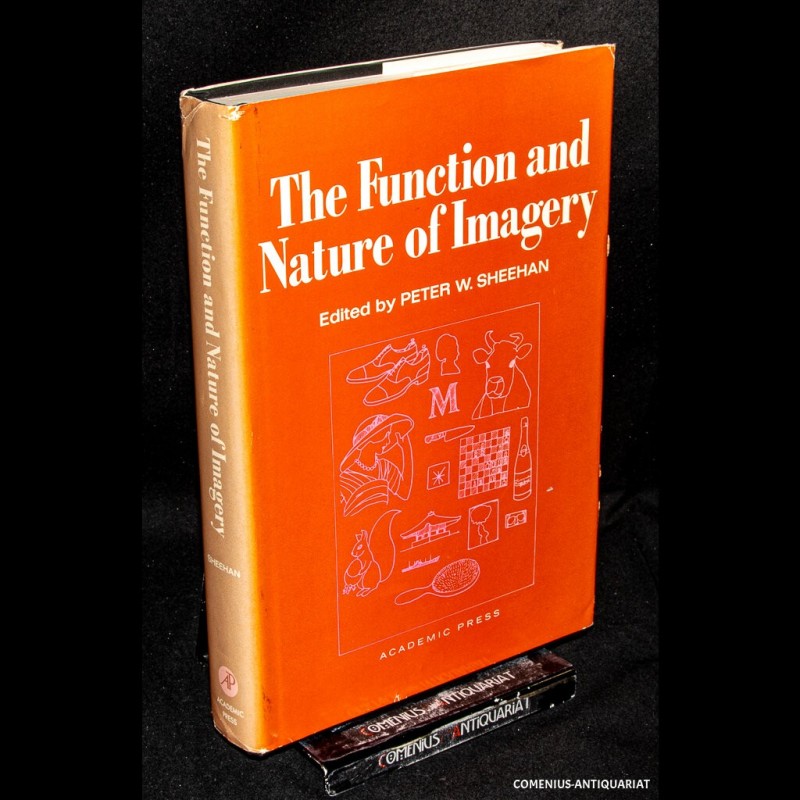Sheehan, Peter W. [ed.],
The Function and Nature of Imagery. New York, London: Academic Press, 1972. xvi, 409 Seiten mit Literaturverzeichnis und Register. Leinen mit Schutzumschlag. Grossoktav. 235 x 163 mm. 886 g
* Rücken oben bestossen, Schutzumschlag mit Gebrauchsspuren.
Bestell-Nr.158442
Sheehan |
Psychologie |
Philosophie
THE FUNCTION AND NATURE OF IMAGERY
The rise of behaviorism at the beginning of the century as the ruling theory of psychology relegated one of the paramount concerns of the earlier psychologists — the study of the image — to a position of not just neglect, but disgrace. In recent years, however, psychologists have begun to look again at the old "mentalist" concepts and phenomena, but now their research is informed by the sophisticated methodologies developed by behaviorists. This book surveys a broad spectrum of the new work on mental imagery. Its three main sections comprise: (1) discussions of the field in general from a historical, introspective, and philosophical perspective; (2) closely defined analyses of specific research problems and issues in imagery function; (3) formal theoretical papers on the theory and function of imagery. The research reports in section two consider the effect on imagery of variations in vividness, controllability, and sensory reference; the interactions of image and personality in daydreaming; assimilation; and unexpected recall. The final section provides theories of imaging as a constructive process related to perception, a mediating variable in verbal learning, a process in cognition, and an instance of muted roletaking. The final chapter discusses the physiological correlates of visual imagery. The book will be of great interest to both students and research workers in the fields of psychology, sociology, psychiatry, and anthropology.
CONTENTS
List of Contributors
xi
Preface
xiii
Section 1 SOME GENERAL VIEWPOINTS
ON IMAGERY
Chapter 1 On the Nature and Generality of Mental Imagery
Robert R. Holt
Some Philosophical Issues 6
Some Definitions and Theoretical Propositions 10
On the Interrelatedness of Various Types of Imagery 14
Effects of LSD on Voluntary Control of Imagery 23
Discussion 24
References 31
Chapter 2 Imagery from the Standpoint of Introspection
Peter McKellar
Three Types of Imagery 36
Hypnagogic Experiences 40
Related Imagery Phenomena 45
Synaesthetic Imagery 46
Hallucinogens 50
Immediate Memory Imagery 53
Aftersensations 54
A-Thinking and R-Thinking 56
58
References
Chapter 3 A Very Private World
Rosemary Gordon
64
The Complexity and Elusiveness of Imagery 68
Image Modality and the Artist
Imagery and Psychotherapy 74
The Function of Imagery 77
Imagery and Art 78
Summary and Conclusion 79
References
Section 11 THE FUNCTION OF IMAGERY
Chapter 4 Individual Differences in the Vividness of Visual
Imagery and Their Effect on Function
David F. Marks
83
Introduction 84
Imagery and Memory 98
Imagery and Perception 104
Summary and Conclusions 106
References
Chapter 5 Voluntary Control of the Memory Image
Alan Richardson
The Description, Measurement, and Correlates of Imagery Control 109
The Adaptive Utility of Possessing Different Combinations of Imagery
114
Control and Imagery Vividness
120
Immediate Research Needs
127
Concluding Comment 127
References
Chapter 6 The Sensory Attributes and Functions
of Imagery and Imagery Evoking Stimuli
Martin S, Lindauer
General Aspects of Sensory Imagery: Language and Aesthetics 132
Sensory Imagery and Individual Differences 134
Sensory Imagery and Learning 137
138
A Program of Research
143
Summary
145
References
Chapter 7 A Functional Analysis of the Role of Visual
Imagery in Unexpected Recall
Peter W. Sheehan
Some Historical Antecedents 149
Relevant Experimental Evidence 152
Formulation of a Hypothesis 155
A Program of Research 157
Some Conclusions and Explanatory Comment 168
References 172
Chapter 8 Daydreaming, Imaginal Processes, and Personality:
A Normative Study
Jerome L. Singer and John S. Antrobus
Introduction 175
Daydreaming Scales and Their Correlates 183
Some Implications 199
References 201
Chapter 9 Assimilation of a Stimulus in the Construction
of an Image: The Perky Effect Revisited
Sydney Joelson Segal
Introduction 203
The Experiments 207
Summary of Studies 226
Discussion 227
References 229
Section 111 THE NATURE OF IMAGERY
Chapter 10 Changing Conceptions of Imagery
Ulric Neisser
The Senses Considered as Perceptual Systems 234
Storehouse vs. Process 236
The Problems of Introspection 238
Learning and Remembering as Cognitive Processes 241
The Mnemonic Uses of Imagery 242
Imagery and Perception 245
An Experimental Demonstration of Nonpictorial Imagery 247
Conclusion 249
References 249
Chapter 11 A Theoretical Analysis of the Role of Imagery
in Learning and Memory
Allan Paiviö
Introduction 253
Theoretical Interpretations of Imagery Effects on Memory: An Outline 254
Encoding Factors 255
Storage and Retrieval Processes 260
Further Convergent Evidence on Effective Imagery 273
References 275
Chapter 12 Image Formation: Clinical Observations
and a Cognitive Model
Mardi J. Horowitz
Framework for a Cognitive Model 282
Loss of Control over Intensity of Images 284
Loss of Control over Image Contents 287
List of Criteria for a Model of Image Formation 294
A Conceptual Model of Image Formation 296
References 307
Chapter 13 The Ubiquitous Appearance of Images
Leonard W. Doob
Evidence for the Primitive Nature of Imagery 312
The Functions of Imagery 317
The Development of Imagery 319
Conclusions 325
References 328
Chapter 14 Imagining as Muted Role-Taking:
A Historical-Linguistic Analysis
Theodore R. Sarbin
Introduction 333
Imagination as a Reified Metaphor 335
Imagining as Hypothetical Instantiation (As If Behavior) 339
Experimental Tests of Imagining as Hypothetical Instantiation 342
Degree of Involvement and the "Reality" of Imaginings 344
Metaphoric Coding 348
On the Credibility of Imaginings 350
Summary 352
References 353
Chapter 15 Physiological Correlates of Visual Imagery
Vladislav Zikmund
Introduction 355
Physiological Bases of Visual Imagery 357
Physiological Changes Accompanying Visual Imagery 359
Theoretical Comment and Conclusion 37S
References
Author Index 3S9
Subject Index 399





 Datenschutz
Datenschutz
 Versandkosten
Versandkosten
 Google Mail
Google Mail
